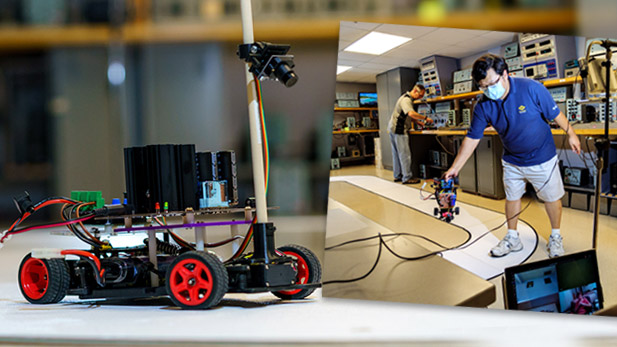It’s Off to the Races in Autonomous Vehicle Challenge

Junior electrical and computer engineering students used their knowledge of circuits, control systems, electronic device modeling and analog electronics to design autonomous racing vehicles this spring.
Teams of junior electrical and computer engineering students gave new perspective to autonomous control when challenged to design vehicles that sped around a race track on campus while the students anxiously watched online from places throughout the country.
It’s another example of the real-world situations that Rose-Hulman provides to prepare students to contribute to a complex global work environment.
“This is as close to simulating a systems approach to design as we can get, and we did it in an online (educational) environment filled with challenges,” admits Mario Simoni, head of the electrical and computer engineering department.
The teams never actually touched their cars. They worked together remotely to design software and electrical systems for a supercapacitor-based power supply and controller that powered an autonomous vehicle to complete laps around an oval track for two minutes – similar to the challenge of the annual NXP Challenge Cup Autonomous Vehicles Competition. Then, after recording the amount of energy used during the race, the cars were completely recharged and electronic adjustments made before returning to the track for another two-minute racing period. Teams were evaluated for the number of laps completed, energy used per lap and total energy consumption during the competition.
Supporting the students’ efforts was 2015 electrical engineering alumnus Thomas Foulkes, who came up with the idea for the design competition during doctoral studies.
Achieving high marks across all performance areas was a vehicle designed by electrical engineering students Caitlin Coverstone and Tiaran Rice along with computer engineering majors Emily Dougherty and Ryan Epstein.
Another top entry was the appropriately named “Team What’s Watt” created by electrical engineering students Will Kocar, Will Kiesel and Jonah Yates, and computer engineering student Chris Comeau.
However, the competition had no winners or losers, and the place finishes were not a grading criteria. Nearly all of the 16 teams completed at least one of the two-minute stages of the competition.
“The students had never designed any circuit this complicated before. This required them to pull together concepts that they had learned in several other courses,” said Simoni, one of two professors for the junior year design course. “Even with that previous knowledge, none of the students had ever worried about heat dissipation, designing for manufacturing or designing for testing. The choices they made had a huge impact on how easy or difficult their design was to manufacture. When it came to testing their design, it was the first time that they had to write an official test plan for one of their designs or work with someone else who tested something they designed.”
Students also experienced the difficulties of making a vehicle drive autonomously in all conditions. Simple shadows and subtle changes in lighting provided technical challenges as vehicle processed camera data to stay within the two black edges of the track. Some vehicles completed laps in smooth motions, while others crisscrossed their way around the track.
“I am proud of the students since they were able to ‘solve’ this design problem even without physical access to the car and power supplies (on campus),” said associate professor Daniel Chang, another of the course’s instructors. “I think this class and how we ran it really shows what Rose is all about. (The instructors and technicians) put our heart and soul into trying to recreate this experience for the students and things like the course’s synchronous live lectures and virtual meetings with each team allowed us to keep some of that ‘individual attention.’”
Students also learned valuable lessons about engineering ethics and printed circuit board design. Simoni acknowledged that a class assignment may have been the first printed circuit board that students had ever created.
At the end of the night, teams had the opportunity, if they desired, for an extra challenge: racing their vehicles on a track filled with several twists, turns and straight-away sections. And, of course, in typical Rose-Hulman fashion, nearly all of the teams were up to the challenge!